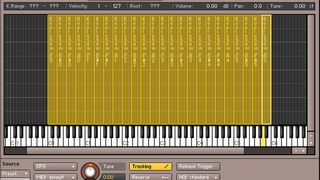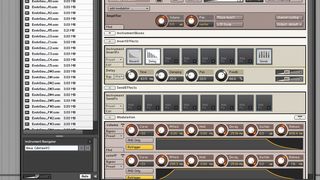How to create a multisampled patch from a monosynth
Ever wish your favourite monosynth could play chords? Increase its polyphony by multisampling your favourite patches - we show you how…
Although the one-note-at-a-time limitation of the classic or modern monosynth is generally appreciated as a 'good thing', making it ideal for basslines, lead lines and other focal synthesised track elements, we've all experienced those moments when we wished our mono could play chords.
Well, the good news that it can… sort of. By capturing a patch from your monosynth in your sampler, you can not only play it polyphonically but also treat it to all sorts of processing and sonic enhancement. And the equally good news is that the techniques involved in making this happen couldn't be easier, as we're about to demonstrate…

Step 1: Let's multisample a characterful sawtooth synth patch from a DSI Mono Evolver Keyboard. After creating a MIDI file that features four notes per octave (C, D#, F# and A) across six octaves, we record in one long take onto an audio track.

Step 2: Once the take has been recorded, we chop it up into individual notes - use your DAW's 'strip silence' function if it has one. Each note is rendered to a separate audio file, and is named according to its key and octave.

Step 3: Next, we drag the samples into Kontakt 5's Mapping Editor. In the Edit > Auto map - Setup menu, we apply both Set to Single Key and Make Root Key: this automatically maps the notes to the key in their filenames.

Step 4: As we've only sampled four notes per octave, we now need to spread the notes across the empty key ranges. To do this, we simply highlight all the notes and drag the range edges to the right, being sure not to overlap them.

Step 5: As the multisamples are keymapped correctly, MIDI notes trigger the synth at the appropriate pitch with unlimited polyphony. After closing the Mapping Editor, we head to the amplitude envelope section and dial in a 600ms release time to lengthen the sound's tail.
Get the MusicRadar Newsletter
Want all the hottest music and gear news, reviews, deals, features and more, direct to your inbox? Sign up here.

Step 6: Finally, we add a low-pass filter module before applying a filter envelope. Delay and reverb effects are also added, and the completed instrument is saved.
Future Music is the number one magazine for today's producers. Packed with technique and technology we'll help you make great new music. All-access artist interviews, in-depth gear reviews, essential production tutorials and much more. Every marvellous monthly edition features reliable reviews of the latest and greatest hardware and software technology and techniques, unparalleled advice, in-depth interviews, sensational free samples and so much more to improve the experience and outcome of your music-making.

"If I wasn't recording albums every month, multiple albums, and I wasn't playing on everyone's songs, I wouldn't need any of this”: Travis Barker reveals his production tricks and gear in a new studio tour

“My management and agent have always tried to cover my back on the road”: Neil Young just axed premium gig tickets following advice from The Cure’s Robert Smith











